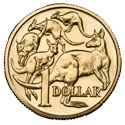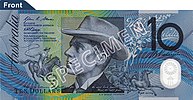Australian dollar
The Australian dollar (sign: $; code: AUD) is the currency of the Commonwealth of Australia, including its external territoriesChristmas Island, Cocos (Keeling) Islands, and Norfolk Island, as well as the independentPacific Island states of Kiribati, Nauru, Papua New Guinea, Tonga, Tuvalu and Vanuatu. Within Australia, it is almost always abbreviated with the dollar sign ($), with A$ orAU$ sometimes used to distinguish it from other dollar-denominated currencies.[2][3] It is subdivided into 100 cents.
In 2016, the Australian dollar was the fifth most traded currency in the world, accounting for 6.9% of the world's daily share (down from 8.6% in 2013).[4] It trades in the world foreign exchange markets behind the US dollar, theeuro, the yen and the pound sterling.[5] The Australian dollar is popular with currency traders, because of the comparatively high interest rates in Australia, the relative freedom of the foreign exchange market from government intervention, the general stability of Australia's economy and political system, and the prevailing view that the Australian dollar offers diversification benefits in a portfolio containing the major world currencies, especially because of its greater exposure to Asian economies and the commodities cycle.[6] The currency is commonly referred to by foreign-exchange traders as the "Aussie dollar".
History
With pounds, shillings and pence to be replaced by decimal currency on 14 February 1966, many names for the new currency were suggested. In 1963, Prime Minister, Sir Robert Menzies, a monarchist, wished to name the currency the royal. Other proposed names from a public naming competition included more exotic suggestions such as the austral, the oz, the boomer, the roo, the kanga, theemu, the koala, the digger, the zac, the kwid, the dinkum, and the ming (Menzies' nickname). Menzies' influence resulted in the selection of the royal, and trial designs were prepared and printed by the Reserve Bank of Australia. The Treasurer, Harold Holt, announced the decision in Parliament on 5 June 1963. The royal would be subdivided into 100 cents, but the existing names shilling,florin and crown would be retained for the 10-cent, 20-cent and 50-cent coins respectively. The name royal for the currency proved very unpopular,[why?] with Holt and his wife even receiving death threats.[citation needed] On 24 July Holt told the Cabinet the decision had been a "terrible mistake" and it would need to be revisited. On 18 September Holt advised Parliament that the name was to be the dollar, of 100 cents.[7][8]
The Australian pound, introduced in 1910 and officially distinct in value from the pound sterling since devaluation in 1931,[9] was replaced by the dollar on 14 February 1966.[10]The rate of conversion for the new decimal currency was two dollars per Australian pound, or ten Australian shillings per dollar. The exchange rate was pegged to the pound sterling at a rate of $1 = 8 shillings ($2.50 = UK £1). In 1967, Australia effectively left thesterling area, when the pound sterling was devalued against the US dollar and the Australian dollar did not follow. It maintained its peg to the US dollar at the rate of A$1 = US$1.12.
On 27 September 2012, the Reserve Bank of Australia stated that it had ordered work on a project to upgrade the current banknotes. The upgraded banknotes would incorporate a number of new features so that they would remain secure into the future.[11] The first new banknotes (of the five dollar denomination) were issued from 1 September 2016, with the remaining denominations to be issued in the coming years.[12]
Coins
In 1966, coins were introduced in denominations of 1, 2, 5, 10, 20 and 50 cents. The initial 50-cent coins contained high silver (80%) content and were withdrawn after a year after the intrinsic value of the silver content was found to exceed the face value of the coins. One-dollar coins were introduced in 1984, followed by two-dollar coins in 1988. The one- and two-cent coins were discontinued in 1991 and withdrawn from circulation. In commemoration of the 40th anniversary of decimal currency, the 2006 mint proof and uncirculated sets included one- and two-cent coins. In early 2013, Australia's first triangular coin was introduced, to mark the 25th anniversary of the opening of Parliament House. The silver $5 coin is 99.9% silver and depicts Parliament House as viewed from one of its courtyards.[13] Cash transactions are rounded to the nearest five cents. As with most public changes to currency systems, there has been a great amount of seignorage of the discontinued coins. All coins portray the reigning Australian Sovereign, QueenElizabeth II, on the obverse, and are produced by the Royal Australian Mint.
Australia has regularly issued commemorative 50-cent coins. The first was in 1970, commemorating James Cook's exploration along the east coast of the Australian continent, followed in 1977 by a coin for Queen Elizabeth II's Silver Jubilee, the wedding of Charles, Prince of Wales and Lady Diana Spencer in 1981, the BrisbaneCommonwealth Games in 1982, and theAustralian Bicentenary in 1988. Issues expanded into greater numbers in the 1990s and the 21st century, responding to collector demand. Australia has also made special issues of 20-cent, one-dollar and two-dollar coins.
Current Australian 5-, 10- and 20-cent coins are identical in size to the former Australian, New Zealand, and British sixpence, shilling, and two shilling (florin) coins. In 1990, the UK replaced these coins with smaller versions, as did New Zealand in 2006 – at the same time discontinuing the five-cent coin. With a mass of 15.55 grams (0.549 oz) and a diameter of 31.51 millimetres (11⁄4 in), the Australian 50-cent coin is one of the largest coins used in the world today. In circulation, the old New Zealand 5-, 10- and 20-cent coins were often mistaken for Australian coins of the same value, owing to their identical size and shape. Until the size of the New Zealand coins was changed in 2004, Australian coins below the dollar in value were in circulation in both countries. Still, some confusion occurs with the larger-denomination coins in the two countries; Australia's $1 coin is similar in size to New Zealand's $2 coin, and the New Zealand $1 coin is similar in size to Australia's $2 coin. As a result, Australian coins are occasionally found in New Zealand and vice versa.
Banknotes
First series
The first paper issues of the Australian dollar were issued in 1966. The $1, $2, $10 and $20 notes had exact equivalents in the former pound banknotes. The $5 note was issued in 1967, the $50 note was issued in 1973 and the $100 was issued in 1984.[14]
Polymer series
The first polymer banknotes were issued in 1988[15] by the Reserve Bank of Australia, specifically polypropylene polymer banknotes(produced by Note Printing Australia), to commemorate the bicentenary of European settlement in Australia. All Australian notes are now made of polymer. Australia was the first country to develop and use polymer banknotes.
New Polymer series
Value
In 1966, when the dollar was introduced, the international currency relationships were maintained under the Bretton Woods system, a fixed exchange rate system using a U.S. dollar standard. The Australian dollar, however, was effectively pegged to the British pound at an equivalent value of approximately 1 gram of gold.
The highest valuation of the Australian dollar relative to the U.S. dollar was during the period of the peg to the U.S. dollar. On 9 September 1973, the peg was adjusted to US$1.4875, the fluctuation limits being changed to US$1.485–US$1.490;[19] on both 7 December 1973 and 10 December 1973, the noon buying rate in New York City for cable transfers payable in foreign currencies reached its highest point of 1.4885 U.S. dollars to one dollar.[20]
On 12 December 1983, the dollar was floated, allowing its value to fluctuate dependent on supply and demand on international money markets. The decision was made on 8 December 1983 and announced on 9 December 1983.[21]
In the two decades that followed, its highest value relative to the US dollar was $0.881 in December 1988. The lowest ever value of the dollar after it was floated was 47.75 US cents in April 2001.[22] It returned to above 96 US cents in June 2008,[23] and reached 98.49 later that year. Although the value of the dollar fell significantly from this high towards the end of 2008, it gradually recovered in 2009 to 94 US cents.
On 15 October 2010, the dollar reached parity with the US dollar for the first time since becoming a freely traded currency, trading above US$1 for a few seconds.[24] The currency then traded above parity for a sustained period of several days in November, and fluctuated around that mark into 2011.[25]On 27 July 2011, the dollar hit a record high since floating. It traded at a $1.1080 against the US dollar.[26]
Some commentators speculated that the value of the dollar in 2011 was related to Europe's sovereign debt crisis, and Australia's strong ties with material importers in Asia and in particular China.[27]
Economists posit that commodity prices are the dominant driver of the Australian dollar, and this means changes in exchange rates of the Australian dollar occur in ways opposite to many other currencies.[28] For decades, Australia's balance of trade has depended primarily upon commodity exports such as minerals and agricultural products. This means the Australian dollar varies significantly during the business cycle, rallying during global booms as Australia exports raw materials, and falling during recessions as mineral prices slump or when domestic spending overshadows the export earnings outlook. This movement is in the opposite direction to other reserve currencies, which tend to be stronger during market slumps as traders move value from falling stocks into cash.
The Australian dollar is a reserve currency and one of the most traded currencies in the world.[6] Other factors in its popularity include a relative lack of central bank intervention, and general stability of the Australian economy and government.[29] In January 2011 at the World Economic Forum in Davos,Switzerland, Alexey Ulyukaev announced that the Central Bank of Russia would begin keeping Australian dollar reserves.[30]









Comments
Post a Comment